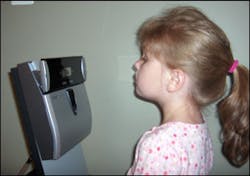Panasonic Iris Readers Implemented for 'CHILD Project' ID Program
Secaucus, N.J. -- With the month of May designated as "National Missing Children's Month", it provided the perfect launch date for the nationwide Children's Identification and Location Database (CHILD) Project. The CHILD Project is a secure, nationwide network and registry enabling law enforcement and social service agencies to positively identify missing children and adults using iris recognition systems from Panasonic Security Systems.
The Nation's Missing Children Organization and National Center for Missing Adults (NMCO), a non-profit agency providing nationwide assistance to law enforcement and families of missing persons, will host the database at its headquarters in Phoenix, Arizona. Unlike fingerprint, voice, facial or photo ID card programs, data obtained using the Panasonic Iris Recognition System will never become obsolete because iris patterns remain the same for life after one year of age.
"No other non-invasive identification system is as precise, easy to use or enduring as iris readers. The CHILD Project is the latest example of how cost-effectively and easily iris readers can be implemented to help provide higher levels of safety and security for the general public," said Tim Meyerhoff, Business Development Manager and Iris Reader Subject Matter Expert for Panasonic Security Systems.
Panasonic's BM-ET330 Iris Reader delivers fast and accurate system enrollment and authentication without the need for any physical contact with the unit. The system's small footprint and portable design also make it easy to set up at local malls for child identification campaigns across the country.
The CHILD Project employs Panasonic's BM-ET330 Iris Readers to capture a detailed image of both irises of the child. The system's enrollment and authentication software, developed by Iridian Technologies, Inc., makes a template or "map" of each person's iris pattern, for storage in the CHILD Project's national database or onto a card that can be kept with the child's family or guardian. To verify identity, an individual simply 'looks into' a Panasonic Iris Reader and the system compares the iris pattern image with iris images stored in the system. If there's a match, the identity is verified.
An advantage of iris recognition technology is that it allows one-to-many searches instead of one-to-one searches as with fingerprint systems. In addition, iris image files are much smaller compared to those for fingerprints -- 512 bytes compared to 1.5 MB -- thereby making the data easier to store and faster to access.
The CHILD Project has already been endorsed by the National Sheriff's Association, with over 1,100 sheriffs across the nation agreeing to participate. This endorsement was prompted by Hampshire County, Massachusetts Sheriff Robert Garvey, who had been using iris recognition technology to track inmates in the county's correctional facility. Sheriff Garvey originated the idea for expanding the use of iris readers to help identify and locate missing children. His office is the first in the nation to install the Panasonic BM-ET330 Iris Readers. The CHILD Project team, under the leadership of President Sean Mullin, will work with sheriffs' offices that want to participate in the program by helping secure funding for the system from state and federal agencies and private foundations.
Performance features of the BM-ET330 Iris Reader include an advanced self-prompting user guidance system for easy operation, tamper protection using the latest 3DES encryption, and an error rate of only one per 1.2 million. The system features a dual camera system with "one glance" authentication for both eyes. Unlike fingerprint readers, the non-invasive identification and authentication system does not require any physical contact, which also eliminates wear and tear, and contamination issues. In addition, the BM-ET330 Iris Reader features an embedded processor with real-time operation for added reliability versus PC-driven biometrics devices. The units can also be used in a systems configuration or stand-alone. The system is compliant with worldwide safety standards, including, CENELEC, (EN 60825-1) and ANSI RP-27.1-96.
